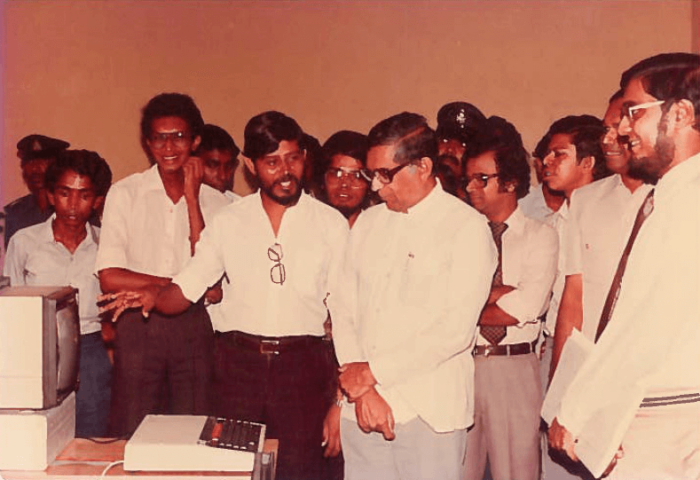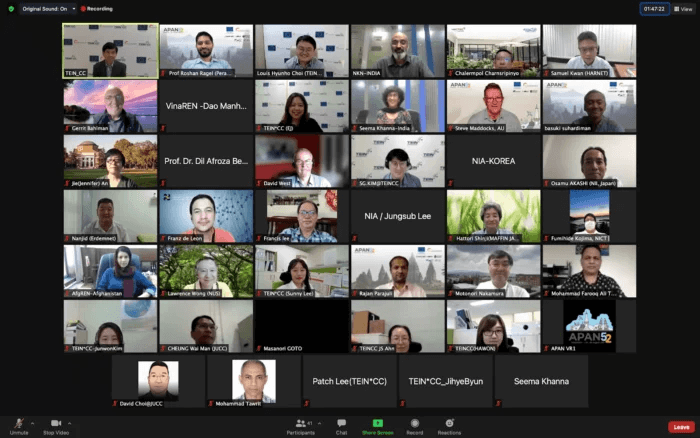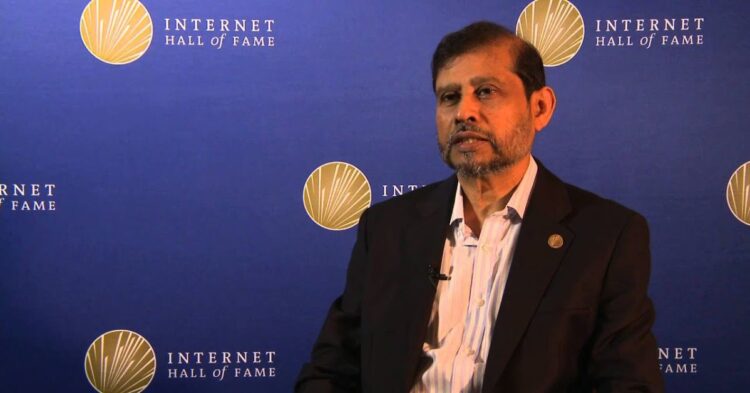It is very easy to think of the Internet as a modern invention, some new-fangled thing of the early 2000s. But the reality is that the Internet and the connectivity we know (and we take so much for granted now) is something that people have been pioneering for more than half a century. One such pioneer is Prof. Abhaya Induruwa, who built Sri Lanka’s first IP-based Wide Area Network – LEARN, and connected it to the global Internet. It was a pivotal step toward widespread internet connectivity in the country. The network remains in operation to this day since its inception in 1989. Over its 33-year history, it has evolved considerably to become a vital pillar connecting Sri Lankan academia and research community with the world.
The Journey of Prof. Abhaya Induruwa
Prof. Abhaya Induruwa first began his career in ICT in the early 70s as a student at the Katubedde Campus of the University of Sri Lanka, now the University of Moratuwa. He earned his Ph.D. degree from Imperial College London, the UK, in 1980. Although the Internet was in its infancy, he gained valuable exposure to networked computing during his time at Imperial College. On his return to Sri Lanka, through the 1980s and the 1990s, he built the base of what would go on to form the core of Sri Lanka’s introduction to the Internet.
In the ICT space, Prof. Induruwa has always been a key player. He was appointed to the inaugural board of directors of the Computer and Information Technology Council (CINTEC) of Sri Lanka in 1983. He continued until 1998, chairing many Working Committees contributing to implementing the national ICT policy and developing a national IT strategy. Prof Induruwa contributed to developing and executing ICT policy in the University and education sectors. In connection with the former, he served on the Sri Lanka Inter-University Computing Committee (SLIUCC) of the UGC. An active academic, he founded the Department of Computer Science and Engineering at the University of Moratuwa in 1985 and served as its head until 1998.
The founding of LEARN, led by Prof. Induruwa, was a pivotal step for digital connectivity in the nation. A natural progression was the establishment of LEARNmail in 1990, the first internet email for academic and research institutions in Sri Lanka. Alongside the .LK domain was registered, where he managed its administrative functions. Reminiscing about the early days, Prof Induruwa said, “My vision was to empower our academics, university students, and researchers to embrace and benefit from ICT by sharing knowledge and data with their peers both inside and outside of Sri Lanka.” Over the course of his career, Prof. Induruwa’s contribution to the advances in data communications and networking had a tremendous impact on all who use computer networks and the internet in Sri Lanka. For his pioneering efforts, Prof. Abhaya Induruwa was recognized with an honorary Lifetime Achievement Award by the Internet Society and inducted into the Internet Hall of Fame in 2014. This was followed by the Sri Lanka chapter of the Internet Society felicitating him in 2015 with an Internet pioneers award. In 2017 Sri Lanka Telecom awarded him a Lifetime Achievement Award for his contributions to the digital arena. In 2019 he was felicitated by the LEARN Association at the 30th Anniversary celebrations of LEARN.
LEARN and the path to Sri Lankan internet
The journey to Lankan internet begins with a proposal submitted by Prof. Induruwa in 1989 to the Government of Sri Lanka through the University Grants Commission and the Ministry of Higher Education, Science & Technology. This proposal was to build the Lanka Experimental Academic and Research Network (LEARN). This network could connect every university in the country and allow them to share information and data.
Since its inception, the LEARN network has come a long way. Its managing body has been incorporated as a company and is the NREN (National Research and Education Network) of Sri Lanka. It offers connectivity and other services to 45 educational and research institutions. This list includes the UGC, all UGC-funded state universities, government institutes, private and semi-government institutes, the Ministry of Higher Education, and national research institutions.
But when it was conceptualized, there were no large-scale networks in Sri Lanka. In the early 1990s, the only networks that existed were the few Local Area Networks (LAN) within some Universities. Such networks connected a few computers within the confines of a building. Prof. Induruwa’s vision was to connect universities around the island. In short, to form the first Wide Area Network (WAN) in Sri Lanka and to connect that to the global Internet. This was a momentous undertaking at the time, mainly because digital data transmission infrastructure did not exist in Sri Lanka.
“Before LEARN was born, people realized the need to be able to share information within the Sri Lankan community,” Prof. Induruwa shared, “by the time I proposed LEARN in April 1989, many people were already quite aware of the benefits and the potential of sharing resources. There were many initiatives and experiments during the early 1980s to see where ICT could fit in and what applications it could have within education and other industries. In 1983, then-President J.R. Jayawardene publicly announced that his government would support the development of computing as a national priority and appointed Prof. Mohan Munasinghe to be an advisor to him on developing ICT.”
Building Sri Lanka’s first WAN from the ground up

Despite national endorsement for the field, there were still many challenges regarding establishing LEARN. These ranged from convincing other stakeholders, including Sri Lanka Telecom, of its importance to navigating the complex technical challenges of such an undertaking. More interestingly, this was at a time when the World Wide Web as we know it today had just been proposed by Sir Tim Berners Lee in March 1989, and smartphones were not even invented. Still, the team persevered. Under Prof. Induruwa’s leadership, work began on the LEARN network inside the University of Moratuwa in the early 1990s.
It would take 5 years of hard work before the Lanka Education And Research Network would be operational. When it went online in 1994, LEARN utilized 64kbps radio links – the first of its kind in Sri Lanka – to connect the University of Moratuwa, the University of Colombo, and the Open University of Sri Lanka. Thus, LEARN became the first IP-based WAN in Sri Lanka. But, of course, this was merely the project’s first phase. In the second phase, LEARN was connected in 1996 to the global Internet.
Around this time, many private ISPs began operations in Sri Lanka. Subsequently, in 1996, LEARN gained internet connectivity via a permanent link to the USA provided by SLT. Between 1996 and 1998, the LEARN network connected 3 more educational institutes via 64kbps leased lines. The network was growing, so the LEARN Association was established to streamline the management and administration of the network.
By 1999, LEARN had connected practically every university in Sri Lanka. It was only 5 years prior that such a feat was considered impossible. As the 1990s ended and the 2000s began, LEARN’s bandwidth was upgraded to meet academia’s ever-increasing data consumption requirements. Later in 2009, the LEARN Association was transformed into an incorporated company as LEARN under the UGC.
LEARN today: A vital pillar of Sri Lankan academia

Now, 33 years since its conceptualization, LEARN offers connectivity to 45 educational and research institutions and has a bandwidth of 30Gbps. These speeds are a far cry from the 64kbps connection utilized to connect just 3 universities in 1995 and the original connection of 2,400 bits per second used for LEARNmail. Today, LEARN offers a variety of services. These services include on-premises video conferencing facilities, Voice over IP (VoIP) connectivity, Federated Identity Access, an international education roaming service (aka eduroam), a Learning Management System (aka LMS) as a pilot project, and a Technical Assistance Center offering engineering support to its member institutes. The primary function of LEARN is to aid the UGC, all of the UGC-funded state universities, the Ministry of Higher Education, as well as a multitude of national research institutions, including the NSF. LEARN has been a vital pillar to these institutions for years by providing high-speed internet connectivity and other services. Its critical importance was visible to all when the pandemic struck. With lockdowns preventing universities from operating, LEARN made on-premises Zoom accounts available to its partner institutions. It was a feat that allowed Sri Lankan higher education to move online effortlessly and continue uninterrupted.

“The pandemic took the whole world by surprise. Even the UK hadn’t thought of using Zoom to teach students till the pandemic,” Prof. Induruwa said, “it became the need of the hour, not just in Sri Lanka but globally. The internet became our lifeline for learning, marketing, selling, purchasing. People had never considered the internet necessary, but it was now a part of life. Covid-19 made the whole world think out of the box, and we have to be happy that LEARN could absorb the extra demand that came with it and that our community could benefit from it.”
Beyond these services, the organization has formed strong partnerships to support local researchers. These partnerships have given local researchers access to networks connecting international educational and research institutes. Through these networks, local researchers have greater access to a global pool of knowledge and can better collaborate with their international counterparts to bring innovative ideas to life.
The future of NRENs and LEARN
For 3 decades, LEARN has played an integral role behind the scenes in connecting local academics and researchers with the rest of the world. However, LEARN was born at a time when computer networking in Sri Lanka was virtually non-existent. Today, practically anyone can access the internet freely with a basic smartphone. “LEARN was an NREN before there was even a word to describe what an NREN was. But there is still a significant digital divide in the world. I hope that collaboration between different RENs, especially in Asia, Africa, and Latin America, where this divide is still quite evident, will help eradicate that,” Prof. Induruwa said, adding, “However, NRENs are built for the academic and research community. The output they produce should be aimed at enriching the lives of the common person. The way for the future is sharing without boundaries – the moment you put a boundary in place, be it geographical, social, economic, or whatever, development is curtailed, and the benefit is lost. So the whole idea of the internet is to break barriers and make it available to everyone.”
